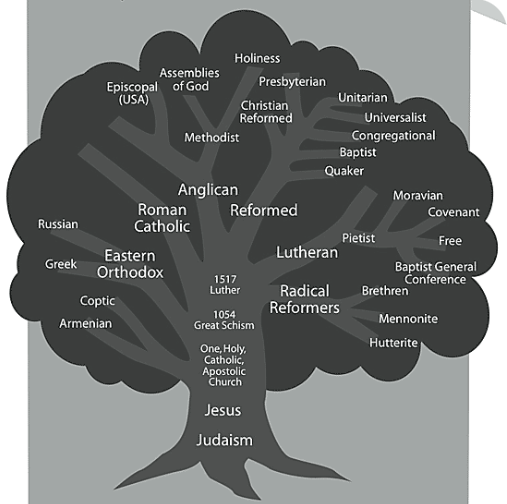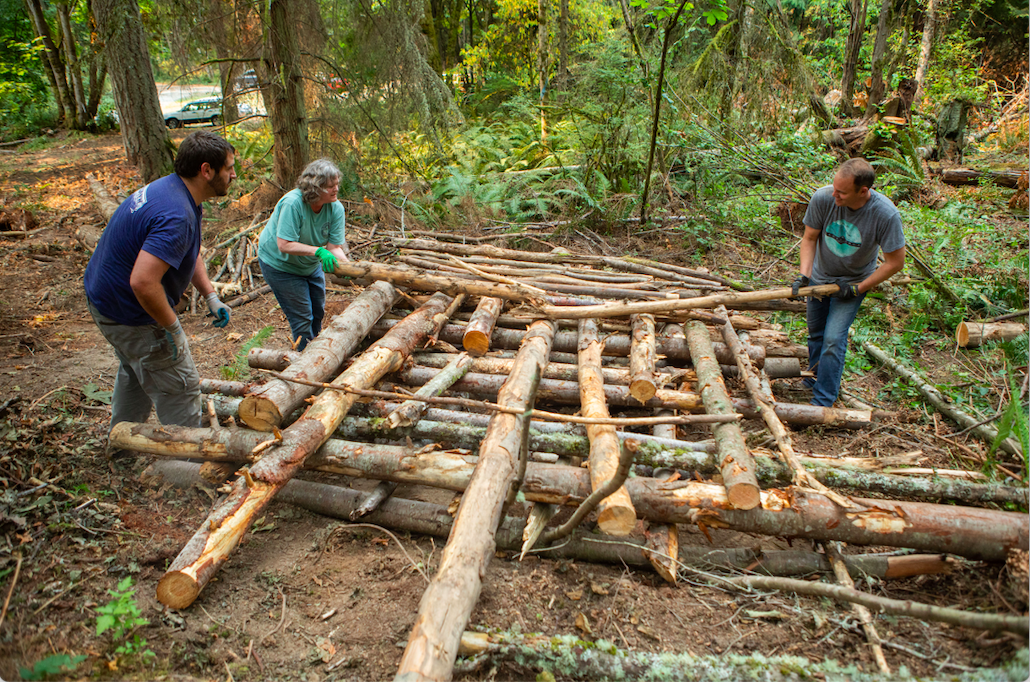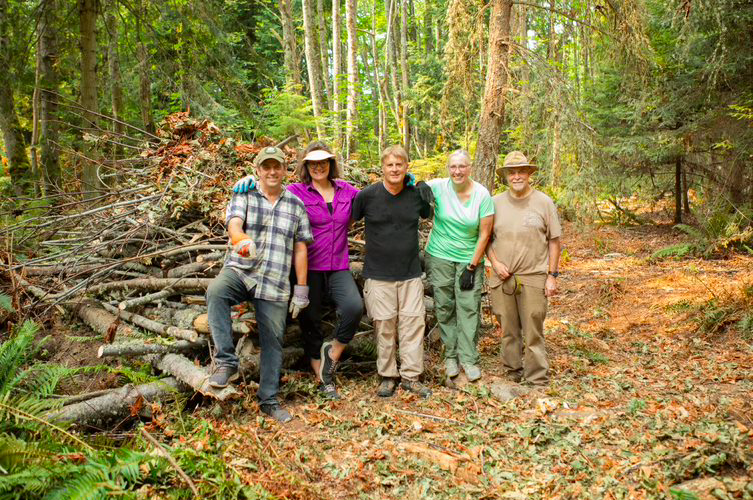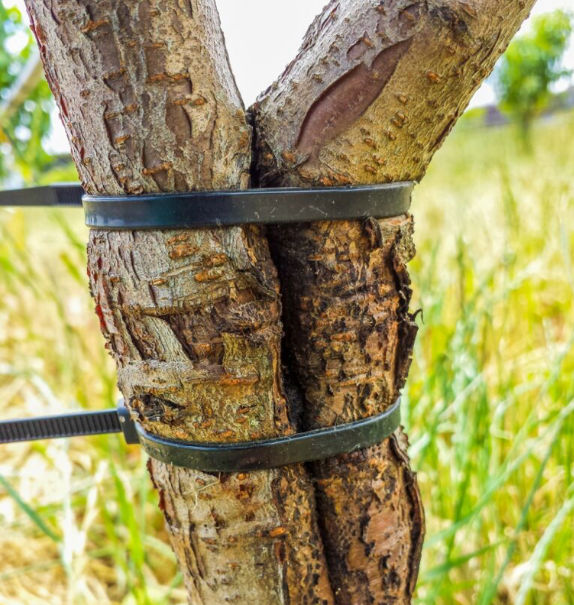When I have the privilege to lead Confirmation, a program that helps middle school aged kids understand the basics of Christianity and develop their personal faith, I explore the nature of the Church through an image that visualizes Christianity as a tree.

The picture helps us remember that the roots of Christianity are in Judaism, that Jesus is the main trunk holding it all together, and that there is one universal Church which has numerous branches. Insofar as the branches are connected to other branches, the trunk, and the roots, the image invites us to appreciate the cultural, theological, political, and geographical forces that have created so many branches over the last two millennia (and there are many more smaller branches not pictured) - a beautiful and creative diversity of faith communities that share a central unity.
I have certainly benefited from this diversity in my own life. I was baptized as an Anglican, raised an Episcopalian, went to a Pentecostal youth group, and had mostly Catholic friends. I attended a non-denominational evangelical college, learned from Jewish teachers in Israel, spent summers working for the Salvation Army, became ordained in the Covenant denomination, went on mission trips with Unitarians, pursued additional education at a Methodist divinity school, and am now part of a Presbyterian congregation. All of these traditions have helped form me as a follower of Jesus (though none of them are perfect), and I am grateful for them.
Though I have been blessed by this diversity, many of the branches in the picture have not been formed by natural growth, but by conflict. Churches have, at times, seen themselves as “the one true branch” and others as not worthy of being part of tree. We see this in the Great Schism of 1054, which splintered the Church into Eastern Orthodox and Roman Catholic branches, and again in 1517 when reformers within the Catholic church eventually split and created a new set of “Protestant” branches.
Instead of a beautiful tree with interconnected branches, Christianity often devolves into a community of splintered sects condemning one another and competing against one another for a share of the religious marketplace. I have heard many Christians condemn their brothers and sisters from other traditions, and have supported family members whose churches have split over theological and social differences (twice!).
Ecological disciples understand that all things are interconnected and interdependent, from literal trees to family trees. This includes, of course, the Church, so we embrace the prayer of Jesus in John 17, “that all of them may be one, Father, just as you are in me and I am in you.” I believe that the ecological crisis we are in presents us with an opportunity to see this prayer realized, to shift us from splintered sects to creative collaborators.
Crisis Response
We are in a crisis: the last official report from the United Nations’ Intergovernmental Panel on Climate Change in 2021 has been described as “a code red for humanity.” The theological and social issues that divide people of faith, while important, seem less so when the planet we share is heating up. Vulnerable communities are already bearing a disproportional share of the consequences, though the impact is beginning to be felt everywhere. A warming Earth induces changes that will be "irreversible’ for centuries to millennia." This is in addition to alarming losses of biodiversity, disturbing levels of plastic pollution, rapid rates of deforestation, and the related rise in food and water insecurity.
In response to this crisis, some people are retreating into social, economic, and geographical enclaves, attempting to secure their future by solidifying and strengthening boundaries. Others are doing the opposite, seeking to knock down boundaries and open up possibilities for mutually beneficial exchange and collaboration. This second path is the one that ecological disciples need to take, and it is laid out by following five commitments:
- Sharing God's love for the world. This is the love that flows from God to us and to all creation. It is also the love that we offer back to God through worship, prayer, and care for what God has made. It is the foundation of unity, care, and collaboration, for it holds all things together.
- Answering God's call to be earthkeepers. This is our sacred human vocation, a common call that has the power to unite through a shared sense of responsibility and purpose-driven projects of healing and restoration.
- Repenting for what we have wrought. This is the acknowledgement that all of us, to greater and lesser extents, have not lived up to our common vocation and need help finding our way back.
- Pursuing new forms of faithful living. We need to share our gifts and creativity in creative collaboration to recover and create ways of living that promote harmony and mutual flourishing, for God's glory and creation's good.
- Envisioning a hopeful future. We need a realistic hope that acknowledges what has been lost, recognizes the obstacles to change, and yet pursues a picture of the world as it should and will be - a world brimming with divine energy, purpose, and life, a “new heavens and a new earth.”
Following these five commitments is not easy. Let me suggest three ways to start moving forward.
Cross Christian Boundaries
Creativity is frequently found in the intersection of two or more different communities, whether that be in estuaries, where fresh water and saltwater combine to bring forth and support unique forms of life, or in ecumenical endeavors, where two or more religious traditions come together in response to a common concern. Both of these examples require movement; the second requires intention. Crossing the boundaries of one’s church is not the same as changing churches or denominations. It involves those who are committed to a particular church or tradition voluntarily seeking interaction with those who are outside their “home faith.”
This can be as simple as learning from other Christian traditions; for ecological disciples, this should include an emphasis on traditions that have cultivated an ecological consciousness in their theology and practice. It could also mean participating in others’ worship services, studying Scripture together, and creating collaborative projects.
There are also local, regional, and international organizations focused on ecological discipleship and mission. One of our readers is part of the Greening Congregations Collaborative of Whidbey Island (go Rick!), and I know others who are part of Young Evangelicals For Climate Action, Interfaith Power and Light, the Laudato Si movement, and the Christian Food Movement. Groups like these are proliferating; chances are good there is something happening near you.
Find Common Ground
Crossing boundaries can also include exploring interfaith and "secular" relationships with people and communities that share ecological values and vision. There are lessons to be learned, and beneficial endeavors to undertake, with those who have different spiritual or philosophical foundations but who share a similar concern and love for Earth and are working for a better future. I am getting to know the good people of Camano Farm and Ashram, for example, and learning from their no-till agricultural methods and community formation.
Non-religious organizations also present opportunities for creative partnerships. Circlewood has benefitted from a relationship with the Northwest Natural Resources Group, which has helped us create a 30-year conservation plan for the Circlewood forest.
Stand For, and On, Something Together
One of Wendell Berry’s well-known sayings is, “What I stand for is what I stand on.” It’s a call to find common ground, literally, to practice earthkeeping right where we are. We can stand together when we recognize the specific foodsheds and watersheds that make our lives possible and come together to care for them. I never imagined that I would be caring for a 40-acre forest on Camano Island, but that is a specific piece of land that I have been entrusted with; it is "what I stand on." Fortunately, I have many creative collaborators helping care for the forest together. We have gathered to remove invasive plants, pick berries, and build habitat piles. We come from several different faith communities, but work together as one.


Building wildlife habitat piles in the Circlewood forest.
A Beautiful Outcome - Healing Splintered Branches
When a branch fully breaks off from a tree, it is virtually impossible to reattach it. However, if the splintered branch still remains attached to the tree, it can be moved back into position, stabilized, and, over time, may heal.

Protestants and Catholics have recently held significant conversations regarding differences that have been overcome and those remain (a sign of ongoing connection). And in 2021, Pope Francis, Ecumenical Patriarch Bartholomew, and Archbishop of Canterbury Justin Welby issued a "Joint Message for the Protection of Creation" that included the following:
As leaders of our Churches, we call on every belief or worldview, to endeavor to listen to the cry of the earth and of people who are poor, examining their behavior and pledging meaningful sacrifices for the sake of the earth which God has given us.
We hope that one day the splintered branches of our faith, and the splintered nature of humanity, will be fully healed. Until that day comes, each one of us can look for ways to be creative collaborators with those who share our faith, and all who share our values, and do our part to bring healing to the Church, humanity, and creation.
With you on the Way,
James
What do you think? Send me an email at james.amadon@circlewood.online.
Special Note: The Ecological Disciple is part of Circlewood, an organization committed to “accelerating the greening of faith.” We are hard at work crossing boundaries, creating partnerships, and caring for common ground. Will you consider standing for a faith that cares for all creation and standing with us? Every gift helps. Learn more HERE.